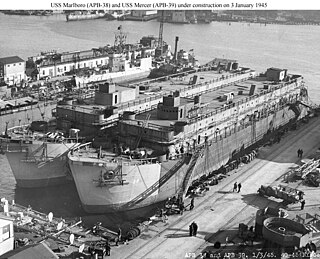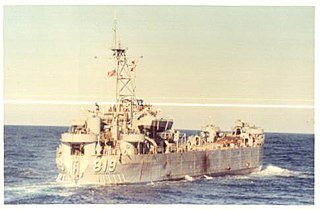
The Military Sealift Command (MSC) is an organization that controls the replenishment and military transport ships of the United States Navy. Military Sealift Command has the responsibility for providing sealift and ocean transportation for all US military services as well as for other government agencies. It first came into existence on 9 July 1949 when the Military Sea Transportation Service (MSTS) became solely responsible for the Department of Defense's ocean transport needs. The MSTS was renamed the Military Sealift Command in 1970.

Technical research ships were used by the United States Navy during the 1960s to gather intelligence by monitoring, recording and analyzing wireless electronic communications of nations in various parts of the world. At the time these ships were active, the mission of the ships was covert and discussion of the true mission was prohibited. The mission of the ships was publicly given as conducting research into atmospheric and communications phenomena. Their designation was AGTR – Auxiliary, General, Technical Research – but it was more or less an open secret that this was a euphemism and they were commonly referred to as "spy ships".

USS Luzerne County (LST-902) was an LST-542-class tank landing ship built for the United States Navy during World War II. Named after Luzerne County, Pennsylvania, she was the only U.S. Naval vessel to bear the name.

The second USS Mercer is an Benewah-class barracks ship of the United States Navy. Originally classified as Barracks Craft APL 39, the ship was reclassified as Self-Propelled Barracks Ship APB 39 on 7 August 1944. Laid down on 24 August 1944 by Boston Navy Yard, and launched on 17 November 1944 as APB 39, sponsored by Mrs. Lillian Gaudette, the ship was named Mercer, after counties in eight states, on 14 March 1945, and commissioned on 19 September 1945.

USS Hampshire County (LST-819) was an LST-542-class tank landing ship built for the United States Navy during World War II. Named for counties in Massachusetts and West Virginia, she was the only U.S. Naval vessel to bear the name.

USS Estero (AG-134/AKL-5) was a Camano-class cargo ship in the United States Navy. She was named after Estero Island off the coast of Florida.

USS Escambia (AO-80) was the lead ship of her subclass of the Suamico class of fleet oilers acquired by the United States Navy for use during World War II. She had the dangerous, but necessary task of providing fuel to vessels in combat and non-combat areas primarily in the Pacific Ocean. For her valiant efforts, she received five battle stars during the war.

USS Madera County (LST-905) was a LST-542-class tank landing ship built for the United States Navy during World War II. Named after Madera County, California, she was the only U.S. Naval vessel to bear the name.

USS Vernon County (LST-1161) was a United States Navy, Terrebonne Parish-class tank landing ship in commission from 1953 to 1973. She saw extensive service in the Vietnam War before being transferred to the Venezuelan Navy, where she became Amazonas (T-21).
USS Camano (AG-130/AKL-1) was an Army Design 381 coastal freighter acquired by the United States Navy 16 July 1947 at Apra Harbor, Guam and became the lead ship of her class of cargo ship. She was configured as a Navy transport and cargo ship and operated with the U.S. Pacific Fleet until 1951, when she was turned over to the U.S. Department of the Interior.
USS Ryer (AG-138/AKL-9) was a Camano-class cargo ship constructed for the U.S. Army as the Freight and Supply Ship USA FS-361 shortly before the end of World War II. On delivery the ship was U.S. Coast Guard crewed and assigned to serve the Southwest Pacific area during the war. The ship was acquired by the U.S. Navy in 1947, configured as a transport and cargo ship, named and was Commissioned, Miscellaneous Auxiliary, USS Ryer (AG-138), 8 June 1947 and reclassified Light Cargo Ship, (AKL-9), 31 March 1949.

USS Hewell (AG-145/AKL-14) was a Camano-class cargo ship constructed for the U.S. Army as FS-391 shortly before the end of World War II. FS-391 operated with a U.S. Coast Guard crew in the Southwest Pacific area. The ship was acquired by the U.S. Navy in 1948. She was configured as a transport and cargo ship and served with the U.S. Pacific Fleet – including highly decorated service during the Korean War – until decommissioned in 1955.
USS Hennepin (AK-187) was an Alamosa-class cargo ship that served the US Navy during the final months of World War II. Post-war she served briefly with the US Army as USAT Hennepin, and then as USNS Hennepin (T-AK-187) with the Military Sea Transportation Service (MSTS) where she was awarded a battle star. She was declared excess-to-needs on 27 March 1959.
USS Herkimer (AK-188) was an Alamosa-class cargo ship that served the US Navy during the final months of World War II. Post-war she served in the Pacific Ocean theatre of operations for some time with the US Army as USAT Herkimer, and then as USNS Herkimer (T-AK-188), with the Military Sea Transportation Service (MSTS) from 1950 to 1973. She was then transferred to the navy of the Trust Territory of the Pacific Islands (TTPI).

USS Tioga County (LST-1158), previously USS LST-1158, was a United States Navy landing ship tank (LST) in commission from 1953 to 1970, and which then saw non-commissioned Military Sealift Command service as USNS Tioga County (T-LST-1158) from 1972 to 1973.

USS Whitfield County (LST-1169), previously USS LST-1169, was a United States Navy landing ship tank (LST) in commission from 1954 to 1973 which saw service in the Atlantic, Caribbean, and Pacific and saw action in the Vietnam War.
USS Mark (AG-143), was built as the Aircraft Repair variant, Design 427, of the Army FS types as FS-214 for use by the United States Army. She was built at Higgins Industries, New Orleans, Louisiana, completed in December 1944. The ship was designed with the well deck covered to provide shop space for the work of repairing aircraft by an embarked Aircraft Maintenance Unit (Floating).

USNS New Bedford (FS-289/AKL-17) was a Navy owned Military Sea Transportation Service civilian crewed Camano-class cargo ship originally constructed for the U.S. Army as the coastal freighter FS-289 shortly before the end of World War II.

USS Tutuila (ARG-4) was a Luzon-class internal combustion engine repair ship that saw service in the United States Navy during World War II, The Korean War, and The Vietnam War as well as several smaller actions. Named for the Island of Tutuila, the largest and main island of American Samoa, it was the second US Naval vessel to bear the name. After serving for nearly 30 years Tutuila was sold to the Republic of China in 1972.

The USS Banner was originally U.S. Army FS-345 serving in the Southwest Pacific during the closing days of World War II as one of the Army's United States Coast Guard crewed ships. In 1950 the ship was acquired by the Navy and converted into a light auxiliary cargo (AKL). In 1967 the ship was converted for electronic intelligence and reclassified as Auxiliary General Environmental Research (AGER).
















